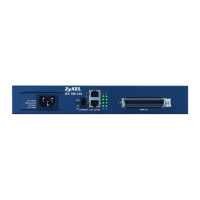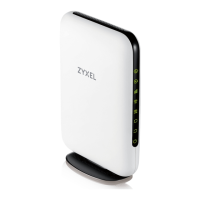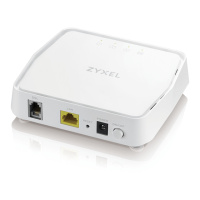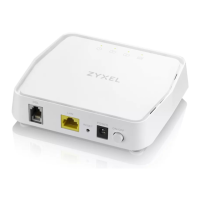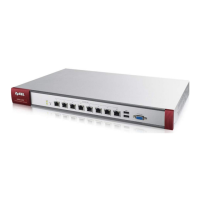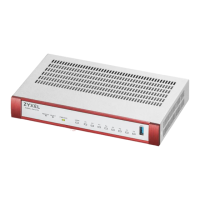
Do you have a question about the ZyXEL Communications USG FLEX H Series and is the answer not in the manual?
| Type | Firewall |
|---|---|
| Interfaces | Ethernet |
| Security Features | Firewall, IPS, Anti-Virus, Anti-Spam |
| VPN Protocols | IPSec, SSL, L2TP, PPTP |
| Management | Web GUI, CLI |
| High Availability (HA) | Yes |
Provides an overview of the Zyxel Device and its supported models.
Details the process for registering the Zyxel Device with the Nebula Control Center.
Outlines the methods available for managing the Zyxel Device.
Explains how to access and use the Web Configurator for device management.
Describes the purpose and steps of the Initial Setup Wizard.
Guides through configuring internet connection settings like DHCP or Static IP.
Explains the process of registering the Zyxel Device for service activation.
Details how security services are activated automatically after device registration.
Describes the front and rear panels and port features of the Zyxel Device models.
Summarizes installation options: desktop, wall-mounting, and rack-mounting.
Provides instructions on using the power cord lock for securing the power cord.
Details the default configurations for zones, interfaces, and ports on Zyxel Devices.
Introduces the Dashboard screens for checking device status information.
Displays general device information, system status, and resource usage.
Provides an overview of the security status information of the Zyxel Device.
Explains how to use Monitor screens to check status and statistics information.
Displays packet statistics for each Gigabit Ethernet port.
Shows packet statistics for each interface, used in system operation.
Provides details on CPU usage, memory usage, and session usage.
Manages the use of various applications on the network with action and log settings.
Enables control over access to specific websites or web content.
Configures settings for IP Reputation, DNS Threat Filter, and URL Threat filtering.
Displays Intrusion Prevention System (IPS) statistics and manages signatures.
Displays anti-malware statistics and configures detection and actions.
Decrypts SSL traffic for inspection by security services.
Provides a safe environment to analyze unknown or untrusted programs and codes.
Lists all of the Zyxel Device’s interfaces and their information.
Displays established sessions for debugging or statistical analysis.
Collects status and basic information of clients connected to Zyxel Device interfaces.
Shows a list of users currently logged into the Zyxel Device.
Lists interfaces and their DHCP-assigned IP addresses.
Displays and manages active IPSec SAs and remote access VPN clients.
Tracks SSL VPN clients logged into the Zyxel Device and manages connections.
Guides on registering the Zyxel Device and managing service subscriptions.
Displays the status of service registrations and license upgrades.
Explains how to download the latest signatures for licensed services.
Covers configuring Zyxel Device interfaces and creating new ones.
Allows viewing Zyxel Device interface settings.
Guides on configuring external and internal interface settings.
Explains how to combine network segments into a single network using bridges.
Details IPSec VPN Tunnel Interface configuration and restrictions.
Explains using trunks for WAN traffic load balancing and reliability.
Lists configured trunks and their load balancing algorithms.
Covers configuring port settings, speed, and duplex modes.
Explains overriding default routing behavior using policy and static routes.
Allows viewing and configuring policy routes and bandwidth management.
Displays and configures static routes for network traffic.
Introduces Network Address Translation (NAT) for managing IP addresses.
Provides a summary of NAT rules and allows creation or modification.
Enables creation and editing of NAT rules.
Explains Application Layer Gateway (ALG) for proper FTP operation through NAT.
Allows turning ALGs on/off and configuring port numbers.
Provides an overview of VPNs, focusing on secure communication over the Internet.
Lists VPN connections, gateways, and settings; allows activation/deactivation.
Configures rules for secure remote access to local networks.
Enables secure remote user login using a web browser without VPN router/client.
Allows creation or editing of SSL access policies.
Defines security settings applicable to specific traffic at specific times.
Enables/disables policies, asymmetrical routes, and manages policies.
Introduces DoS prevention profiles and applying them to traffic.
Provides examples of blocking LAN users from accessing specific applications.
Covers address objects, groups, and Geo IP for policy and security settings.
Defines TCP, UDP, and ICMP service objects and service groups.
Explains setting up zones for network security and policy configuration.
Covers setting up one-time and recurring schedules for various policies.
Manages application usage on the network, including protocols and features.
Customizes action and log settings for application patrol signatures.
Demonstrates blocking LAN clients from accessing a specific application like TikTok.
Provides control over access to specific websites or web content.
Enables content filtering, manages policies, and sets denial messages.
Creates a list of good (allowed) web site addresses.
Creates a common list of bad (blocked) web site addresses.
Creates a list of bad (blocked) URL keywords.
Checks which category a web page belongs to.
Shows how to block LAN users from remote WAN applications like TeamViewer.
Configures settings for IP Reputation, DNS Threat Filter, and URL Threat filtering.
Enables IP reputation and specifies actions for bad reputation IP addresses.
Inspects DNS queries for clients and takes action on bad reputation FQDNs.
Enables URL Threat filtering and specifies actions for suspicious activities.
Protects the network from malware by scanning WAN traffic for signatures.
Turns anti-malware on/off and configures block/allow lists for malware patterns.
Specifies file or hash patterns to allow, avoiding false positives.
Specifies file or hash patterns to block and log.
Provides background information on anti-malware scanner types.
Provides a secure environment to analyze unknown or untrusted programs and codes.
Enables sandbox and specifies actions for malicious or suspicious files.
Introduces Intrusion Prevention System (IPS), custom signatures, and updates.
Displays IPS signature information and registration status.
Lists signatures exempted from IPS inspection.
Provides background information on IPS and Snort equivalents.
Allows incoming IP packets to bypass specific security services based on source/destination.
Views the IP exception list for specified services.
Demonstrates creating an IP Exception profile to bypass specific security services.
Decrypts SSL traffic for inspection by security services.
Provides a template for pre-configured SSL Inspection certificates, actions, and logs.
Configures an exclusion list to bypass matching sessions to destination servers.
Updates the latest certificates of servers using SSL connections.
Steps to install a certificate in a computer's Windows operating system browser.
Describes setting up user accounts, groups, and rules for Zyxel Device traffic.
Explains setting up AAA servers and two-factor authentication.
Details how to use AAA servers for network access control.
Introduces the mechanism for double-layer security access.
Covers configuring general Zyxel Device settings.
Configures hostname, system time, connection settings, and language.
Explains Simple Network Management Protocol for managing network devices.
Covers DNS server configuration for domain name resolution and DDNS.
Configures mail server settings and alert settings for reports.
Explains how certificates authenticate users based on public-private key pairs.
Provides a summary list of Zyxel Device's certificates and requests.
Manages certificates accepted by Zyxel Device as trusted.
Covers configuring daily reporting and log settings.
Displays Zyxel Device log messages and allows filtering.
Controls log messages, alerts, and storage on USB or syslog servers.
Security analytics portal for log analysis, anomaly detection, and threat reporting.
Configures daily traffic reports and statistics via email.
Defines configuration files and covers storing, naming, and editing them.
Stores, runs, and names configuration files; allows download/upload.
Checks current firmware version and uploads new firmware.
Provides an overview of diagnostic screens for troubleshooting.
Generates configuration and diagnostic information files for customer support.
Captures network traffic files for analysis using a packet analyzer.
Views CPU and memory performance of applications.
Lists diagnostic information files stored on the Zyxel Device or USB.
Performs network tests like ping and traceroute.
Instructions for rebooting the Zyxel Device.
Provides options to reboot or shutdown the Zyxel Device.
Troubleshooting steps for when device LEDs do not illuminate.
Steps to resolve issues accessing the Zyxel Device from the local network.
Troubleshooting steps for when internet access is unavailable.
Checks license and internet connection for signature update issues.
Ensures IPS is in Prevention mode for actions to take effect.
Verifies internet connection for content filter service functionality.
Ensures interfaces are assigned to zones for security settings to apply.
Verifies custom policy route order for correct traffic application.
Addresses issues where interface IP address changes affect rules.
Requires ISP account setup before creating PPPoE or PPTP interfaces.
Clarifies that each VLAN interface is created on top of only one Ethernet interface.
Suggests optimizing application patrol entry order for performance.
Explains file handling when malware is partially removed.
Recommends enabling 'Destroy Infected File' and logs for alerts.
Checks if file types are included in Sandboxing options.
Ensures security features have logs enabled for notifications.
Troubleshooting steps for Dynamic DNS connectivity issues.
Verifies if the FTP ALG is enabled for application patrol.
Addresses issues related to asymmetrical or triangle routes.
Troubleshooting steps for IPSec VPN tunnel configuration errors.
Lists essential details needed when contacting customer support.
Provides contact information for Zyxel's worldwide headquarters.
States the copyright information for the publication.
Disclaims liability for product application or use issues.
Provides regulatory information for Class B digital devices.
Details FCC compliance rules for device operation in the USA.
Covers ecodesign requirements for energy-related products.
Provides guidelines for proper disposal and recycling of the product.
Lists ISO 3166 2-letter country codes.
Lists important safety precautions for device usage and handling.





